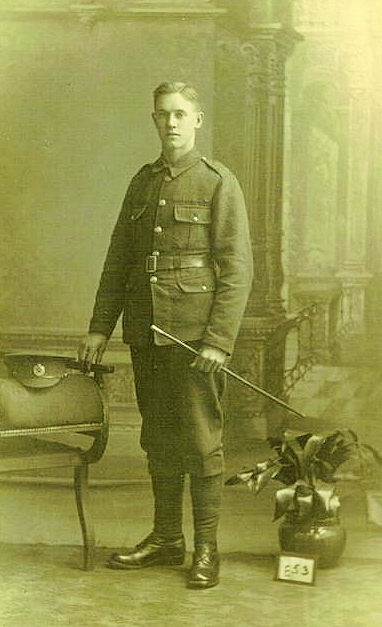
Figure 1. 290 Sapper J.E.E. Buckland, R.E., c. 1915.
(Image courtesy of the Imperial War Museum)
520143
2nd
Corporal
JOHN EDWARD ERNEST BUCKLAND
Royal Engineers
By
Lieutenant Colonel (Retired)
Edward De Santis, MSCE, P.E., MinstRE
U.S. Army Corps of
Engineers
(May 2023)

Figure
1. 290 Sapper J.E.E. Buckland, R.E., c. 1915.
(Image
courtesy of the Imperial War Museum)
1. INTRODUCTION
This research was prompted by the photograph in Figure 1 which was encountered by the author on the Imperial War Museum (IWM) web site. Photographs and information about 2nd Corporal Buckland were contributed to the web site by a person whose user name is Bryan5462. Bryan5462 has made 150 contributions to the IWM web site and is to be applauded for his diligence in commemorating the service of so many British officers, non-commissioned officers and other ranks who served during the Great War of 1914-1918. I do not know Bryan’s full name, but I thank him for his work.
The majority of the information that I have presented, and all of the photographs in my work, have come from Bryan’s work. He has presented his work on the IWM web site in the form of notes on a timeline of Buckland’s life. By my work here I hope to present a more fluid narrative account of that life, with primary emphasis on his military service. Where no citation is given as the source of information in this work, the reader should assume that it came from the IWM web site.
2. PRE-SERVICE LIFE
John Edward Ernest Buckland was born on 12 December 1895 in Swindon, Wiltshire, the son of Frederick James Buckland (1855-1906) and Fanny Buckland, née Hatcher (1855-1934).[1] On 12 June 1910 young John began an Apprenticeship as a Coppersmith at the Carriage Works of the Great Western Railway at the railways Swindon works.
3. ENLISTMENT AND TRAINING
Enlistment
On 2 October 1914 Buckland enlisted in the Royal Engineers Territorial Force (T.F.) and he was posted as a Sapper, Regimental Number 290, to the 1st Wiltshire Fortress Company, R.E. (T.F.).[2] The 1st Wiltshire Fortress Company Royal Engineers was a part-time unit of Britain's Royal Engineers formed in 1908. It helped to defend the naval base of Portland Harbour and provided a detachment to serve with the British Expeditionary Force (BEF) on the Western Front.[3]
Training
Following the administrative actions involved with his enlistment Buckland was posted to his Territorial Force unit in Wiltshire where he received some recruit training. The amount and type of training that he received was nothing like that given to a soldier enlisting in the Royal Engineers of the Regular Army. For Regular Army R.E. soldiers, with the exception of Drivers, every recruit enlisted for the Royal Engineers had to have a trade. Pioneers and Sappers were sent to Chatham where they were trained in infantry drill and pioneer duties. The engineer recruits also received musketry training. When the course of training was completed the recruits had to pass an examination and were then transferred to engineer formations, where they received higher pay and could earn extra allowances by working at their special trades. During the Great War the training cycle was shortened to about eight weeks before the man was posted to a field unit. Since Buckland was a Coppersmith in civil life before he enlisted, he probably was employed in metal-working with his unit.
On the outbreak of war in August 1914, the fortress engineers moved to their war stations in the coastal defences. The Wiltshire Fortress Company was undergoing its annual training at Fort Purbrook, Portsmouth, and went straight from there to Weymouth, where along with the Dorset Fortress Company and work details from infantry battalions, it worked on completing the Portland defences.
4. POSTINGS, ASSIGNMENTS AND CAMPAIGN SERVICE
Home Service (1914-1915)
Shortly after the outbreak of war, the men of the Territorial Force were asked to volunteer for overseas service and War Office instructions were issued to form those men who had only signed up for home service into reserve or 2nd Line units. They absorbed and trained most of the recruits that flooded in, and supplied drafts to the units on active service. Some of the extra recruits for the Wiltshire company came from the Weymouth area, most of the others from the Great Western Railway works.[4] John Buckland was part of this group.
The 1st Wiltshire Fortress Company did go overseas. The Portland defence works were completed by November 1914, and the men underwent a month of strenuous training, including heavy bridge building and constructing trenches at night. It then embarked aboard the SS Blackwell and arrived at Le Havre on 20 January 1915 to join the BEF in France.[5]
France (1915-1918)
In September 1915 the 1st Wiltshire Fortress Company was converted to an Army Troops Company and was renumbered as the 565th (Wiltshire) Army Troops Company. 290 Sapper John Edward Ernest Buckland joined the company in France on 18 September 1915. Unlike field companies which were assigned to divisions and worked close to the front lines, army troops companies worked under the control of an army or corps headquarters to the rear of the divisions. The army troops companies generally worked on lines of communications, but they could be tasked with other field engineering work in support of operations in the field as will be seen when its work during the battles and campaigns of the Great War are described below.
The officers of the 565th (Wiltshire) Army Troops Company in 1914/15 were all engineers from the Railway Works and included:[6]
· Major Frederick George Wright, R.E. (Officer Commanding)
· Captain Cyril Spencer Wilson, R.E. (Second-in-Command)[7]
· Lieutenant John Dawson, R.E. (Section Leader)[8]
· Lieutenant Septimus Edward Tyrwhitt, R.E. (Section Leader)
· Lieutenant David Williams, R.E. (Section Leader)
· Lieutenant George Ernest Crisford Knapp, R.E. (Section Leader)[9]
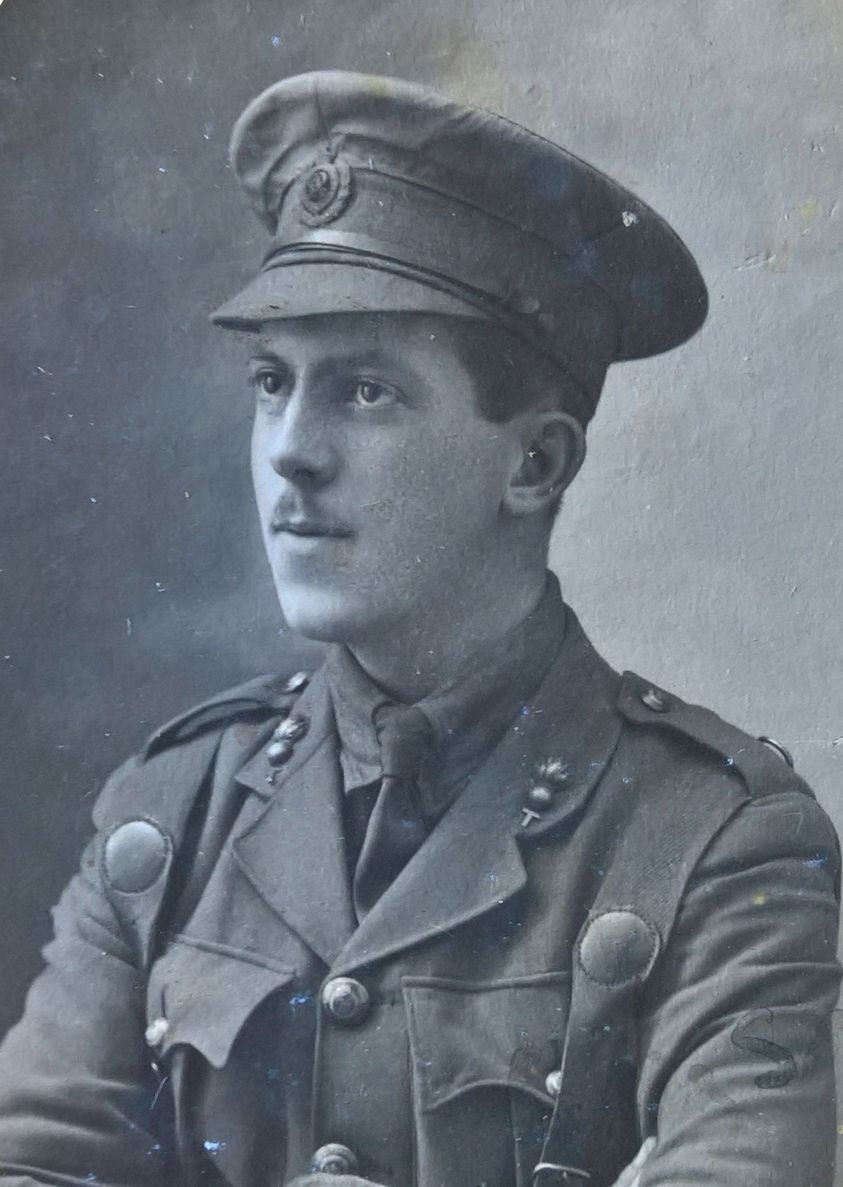
Figure
2. Lieutenant George Ernest Crisford Knapp, R.E.
(Image
courtesy of British Army Ancestors)
Henry Cotens Rodda (Regimental Number 2), a South African War veteran, was the Company Sergeant Major, and was later commissioned as Lieutenant in the Company.[10]
The Somme (1915-1917)
Buckland and his company spent the autumn and winter of 1915–16 building a new mill at Steenwerck and a hospital nearby at Trois Ambres, as well as working on roads, light railways and water supplies. The Battle of the Somme opened on 1 July 1916 and shortly afterwards the 565th (Wiltshire) Army Troops Company was moved into the area to camp at Bronfay Farm and worked on water supplies in the Carnoy Valley.[11] This work continued throughout the Somme offensive, and the company built a pumping station on the River Somme with a water pipeline to Trônes Wood after its capture. In the spring of 1917[12] the company was engaged in building a Corps Headquarters camp at Foucaucourt, then a new Headquarters camp for Fourth Army at Villers-Carbonnel near Peronne. This was in the devastated area beyond the old German front line after the German retreat to the Hindenburg Line (Operation Alberich). It then worked on five heavy steel bridges over the Somme at La Chapelette near Peronne.[13]
In 1917, the men of the 565th (Wiltshire) Army Troops Company (ex-Wiltshire Fortress) received new Regimental Numbers in keeping with Kitchener’s New Army organizational structure. The range of numbers initially allotted to the company was 520001 to 522000. This was later changed to 520001 to 521779. Buckland’s new number was 520142.[14]
Dunkirk (1917)
The Third Ypres Offensive was about to begin, and Fourth Army Headquarters was switched to Dunkirk to command a thrust up the coast to meet the expected breakthrough in Flanders. The 565th (Wiltshire) Army Troops Company was sent to fit out the Terminus Hotel at Leffrinckoucke, where some shelling was experienced. Detachments installed water tanks and pumps at Dunkirk docks, and constructed a musketry school near Abbeville.[15]
Cambrai (1917-1918)
In November 1917 the company was sent by lorry to the Third Army's front, where the Hindenburg Line had been breached in the Battle of Cambrai. The company was put to work filling mine craters where the Hindenburg defences crossed the Bapaume–Cambrai road between the Canal du Nord and Graincourt. This was done under sporadic machine gun fire. The men next worked on new defences. After the German counterattack, the company headquarters was moved back to Ervillers, where the men worked in the forward areas on water supplies and building camps.[16]
The German spring offensive of 21 March 1918 broke through in the Cambrai sector, followed by the 'Great Retreat', during which the 565th (Wiltshire) Army Troops Company found itself retreating by day and working on emergency defences with labour battalions by night. When the German offensive ran out of steam, the company was put to building a new defence line between Adinfer Wood and Fonquevillers on the old Somme battlefield. This involved repairing and linking up sections of old British and German trenches. One of the new trenches was named 'Swindon Trench' by the general commanding. During the summer the company had two companies of the U.S. Army Engineers attached to it for instruction.[17]
The company was credited with participation in many of the major actions in 1918 with the British VI Corps. These included the following:[18]
· St. Quentin, 21-23 March
· Bapaume, 24-25 March
· Arras, 28 March
· Ancre, 5 April
· Albert, 21-23 August
· Bapaume, 31 August to 3 September
· Havrincourt, 12 September
Following the action at Havrincourt the company took part in the pursuit of the German forces to the Mons, taking part in the first major action at Canal du Nord.
Canal du Nord (1918)
The Allied counter-offensive (the Hundred Days Offensive) began in August 1918, and the 565th (Wiltshire) Army Troops Company followed the advance, opening up new water points, including an important one at Douchy. On 12 September the company reached Ruyaulcourt where it was given the task of constructing a 300-foot (91-meter) ramp down the face of a retaining wall into the dry Canal du Nord suitable for traffic up to 6-inch guns. This work had to be done under observation from a German Kite balloon, which called down shellfire on the construction site. The balloon was shot down, but at 1600 hours on 18 September the Germans put in a counterattack, preceded by a severe barrage. The company lost one officer and seven sappers killed, 22 wounded (two mortally). One of the men wounded was 2nd Corporal Buckland.[19] See Annex A.
Home (1918)
2nd Corporal Buckland was evacuated to England where he was treated for his wound at the Colliton House Hospital in Dorchester. On 12 October 1918, while convalescing from his wound, Buckland took leave from the hospital for 12 hours and 50 minutes, from 0900 hours to 2150 hours, in order to marry Daisy May Diment, who was living in Weymouth where she worked as a domestic servant.[20] He married her wearing his hospital uniform as shown in Figure 4 below.
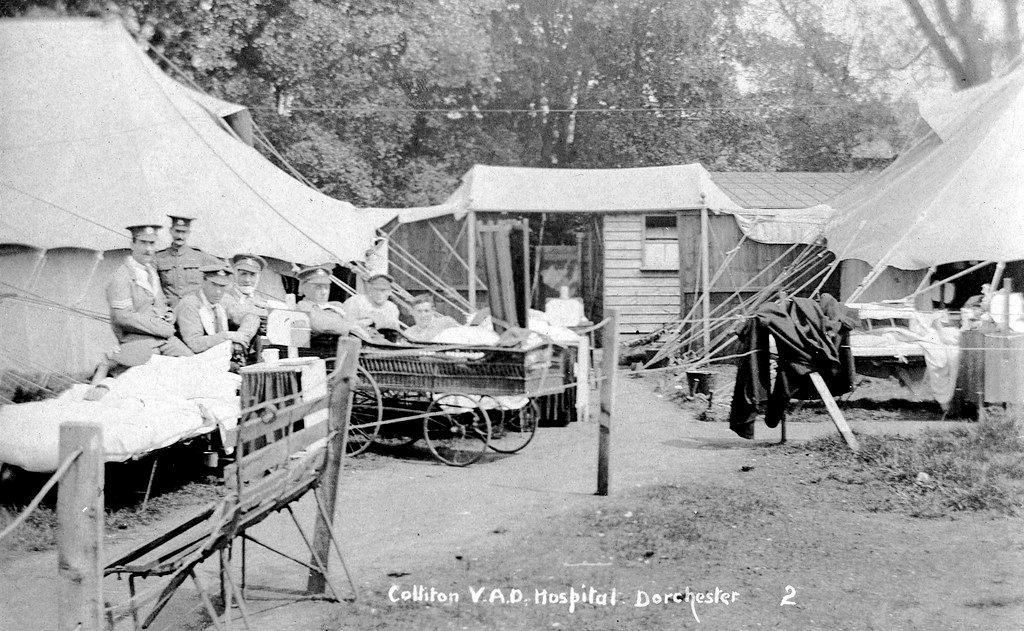
Figure
3. Colliton House Hospital, Dorchester.
(Image courtesy of
Wikipedia)
Colliton House had been built in the 1600s and in 1914 was opened as a hospital. The house was used as an administration block, but the patients were housed in tents in the grounds. It originally housed 40 patients, but this was expanded to 100 over the war. As seen in Figure 3 above, it was a rather crude affair.
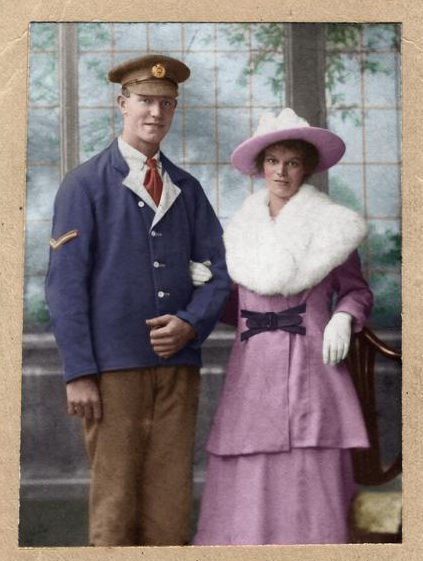
Figure
4. Wedding Photograph of 2nd Corporal
and Mrs. Buckland.
(Image courtesy of IWM:Bryan5462)
Towards the end of October 1918 Buckland was considered to be fully recovered from his wound and he may have been alerted for re-deployment to France, although there is some question that this actually happened. To spend some time with his new wife he applied for and was granted 14 days leave from 14 to 28 October. On 29 October he returned from leave, giving him two days to prepare for his return to his new unit. However, as a result of his wound he was posted to “light duties” with the 4th Reserve Battalion Royal Engineers.[21]
The 4th Reserve Battalion Royal Engineers was formed in January 1918 in Deganwy, Wales. Its mission was to organize the flow of R.E. recruits to New Army units throughout the Corps of Royal Engineers. There is some confusion regarding just where Buckland served with this unit. This confusion stems from his Certificate of Employment during the War (Army Form Z. 18.) as will be seen below.
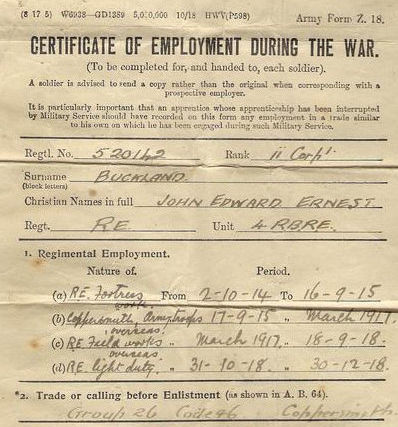
Figure
5. Certificate of Employment of 2nd
Corporal Buckland.
(Image courtesy of IWM: Bryan 5462).
Item (d) under Regimental Employments shows his posting to “light duty” for the period from 31 October 1918 to 30 December 1918. This is the period to which he was posted to the 4th Reserve Battalion, R.E. The word “overseas” is written over the words “light duty” so unless the person making the entry considered Wales to be overseas, this is an obvious error. It seems unlikely in any case that he would have been assigned light duties with the BEF in France.
On 5 June 1919 520142 2nd Corporal John Edward Ernest Buckland, 4th Reserve Battalion, R.E. was demobilized at No. 1 Dispersal Unit in Fovant, Wiltshire. His address for pay purposes was 1 Cove Road in Weymouth. His Medical Category was B2, undoubtedly because of his wound. This category indicated that he was able to walk 5 miles and to see and hear sufficiently for ordinary purposes. His place of rejoining the forces in the event of an emergency was Swindon.[22]
On 2 February 1919 Buckland was transferred to the Class “Z” Army Reserve. His Certificate of Transfer to Reserve on Demobilization (Army Form Z. 21.) provided the same information as given above with the addition of his Specialist Military Qualification of “Very Superior” Coppersmith.
5. MEDALS, AWARDS AND DECORATIONS
For his service during the Great War of 1914-1918 2nd Corporal Buckland was awarded the following medals:
1914-15 Star
British War Medal
Victory Medal
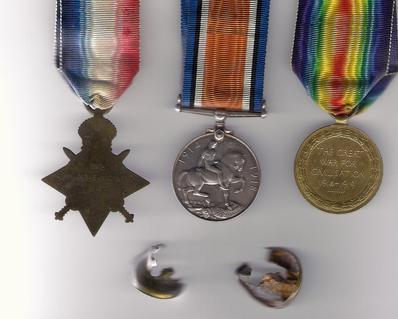
Figure
6. The Medals of 2nd Corporal J.E.E.
Buckland, R.E.
(Image courtesy of IWM:Bryan 5462)
NOTE: The image above displays the reverse of his medals; that is, the backs of each medal. The object below the medals is the remainder of his tunic button that was hit in the area of his wound by either a bullet or by shrapnel.
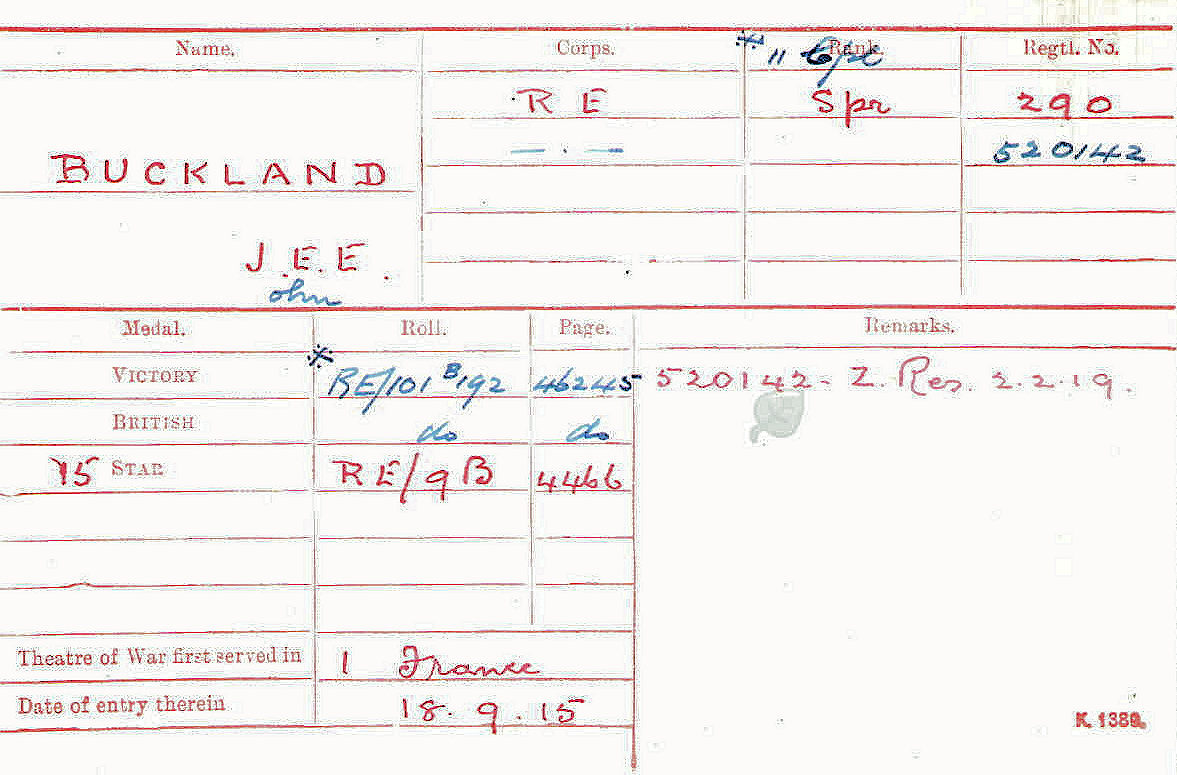
Figure
7. The Medal Index Card of 2nd
Corporal John E.E. Buckland, R.E. Showing His Entitlement to the
Three Medals that He Was Awarded.
(Image courtesy of
Ancestry.com)
6. POST SERVICE LIFE
After leaving the Army in 1919, Burkland returned to the Great Western Railway works in Swindon. It appears that he worked for the GWR until 1955 when he retired.
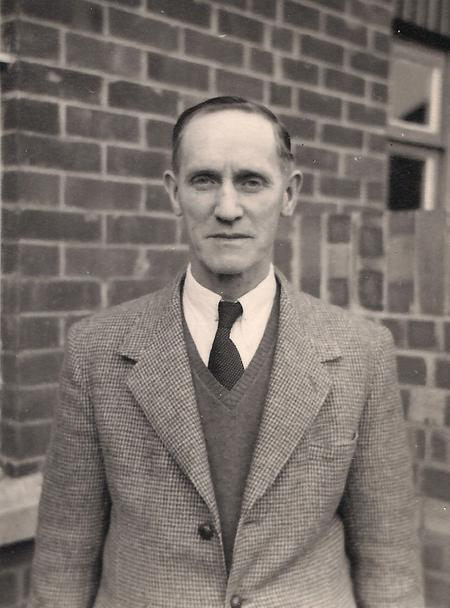
Figure
8. John Edward Ernest Buckland (1895-1980).
(Image courtesy
of IWM:Bryan5462)
ANNEX A
Casualties of
the 565th
(Wiltshire) Army Troops Company During the Great War (from 1915 to
1918)
(in
alphabetical order by date of death)
Name |
|
Rank |
|
Date of Death |
Johnston, Cecil William |
520116 |
Sapper |
Died |
17 Apr 1917 |
Press, William Henry |
520066 |
Sapper |
Died |
7 Oct 1917 |
Edwards, John Henry |
520309 |
Sapper |
KIA |
18 Sep 1918 |
Hatcher, George Leonard |
520092 |
Sapper |
KIA |
18 Sep 1918 |
Johnson, Albert |
520211 |
Sapper |
KIA |
18 Sep 1918 |
Phillips, John Thomas |
486517 |
Sapper |
KIA |
18 Sep 1918 |
Sinnett, S.A. |
520187 |
Sapper |
KIA |
18 Sep 1918 |
Spreadbury, Bertram Byron |
520034 |
Sapper |
KIA |
18 Sep 1918 |
Dixon, Norman Reginald Walker |
520289 |
Sapper |
DOW |
19 Sep 1918 |
Mugford, H.N. |
520171 |
Sapper |
DOW |
19 Sep 1918 |
Paintin, J.E. |
520262 |
Sapper |
Died |
31 Dec 1918 |
Legend: KIA – Killed in Action; DOW – Died of Wounds; Died – of disease or accidentally killed.
The Dorsetshire and Wiltshire Fortress Royal Engineers web site indicates that seven Other Ranks and one Officer were killed in the action at Canal du Nord and two of the wounded died, for a total of one Officer and nine Other Ranks. A search of the Commonwealth War Graves Commission and Soldiers Died database found six O.R.s killed in action and two who died of wounds. A search of Officers Died in the Great War did not find the name of the officer.
REFERENCES:
Civil Documents
Certificate of Apprenticeship as a Coppersmith.
Marriage Certificate, Weymouth, 12 October 1918.
Envelope for Letter from Buckland to Daisy Diment, dated 17 July 1916.
Databases
Soldiers Died in the Great War. The Naval and Military Press, Dallington, East Sussex, 1998.
Officers Died in the Great War. The Naval and Military Press, Dallington, East Sussex, 1998.
Family Trees
John Edward Buckland (Ancestry.com)
Internet Web Sites
Imperial War Museum (Lives of the First World War – Royal Engineers): Contributed by Bryan5462.
https://livesofthefirstworldwar.iwm.org.uk/lifestory/582483
Wikipedia: Dorsetshire and Wiltshire Fortress Royal Engineers
https://en.wikipedia.org/wiki/Dorsetshire_and_Wiltshire_Fortress_Royal_Engineers
British Army Ancestors.
https://www.britisharmyancestors.co.uk/.../captain-knapp.../
Tales from the Supply Depot (Colliton House Hospital)
https://talesfromthesupplydepot.blog/2021/03/07/vad-hospital-postcard/
Renumbering of the Territorial Force Royal Engineers in 1917.
Commonwealth War Graves Commission.
Military Documents
Medal Index Card of 2nd Corporal John E.E. Buckland, R.E.
Certificate of Transfer to Reserve on Demobilization (Army Form Z. 21.).
Certificate of Employment during the War (Army Form Z. 18.).
Protection Certificate and Certificate of Identity (Army Form Z. 11.).
Royal Engineers Medal Roll, British War Medal and Victory Medal.
Periodicals
Battle Honours of the Royal Engineers. The Royal Engineers Journal. The Institution of Royal Engineers, Chatham, Kent, 1925-1932.
ENDNOTES
[1] Family tree.
[2] 290 was his Territorial Force Regimental Number in the unit.
[3] Wikipedia.
[4] Ibid.
[5] Ibid.
[6] IWM: Bryan5462.
[7] Later, Military Cross.
[8] Later Captain, Military Cross and Mention in Despatches.
[9] George Ernest Crisford Knapp was born in the City of London on the 19 February 1895. He was the eldest son of Ernest R Knapp, a Church of England clergyman, and his wife, Katie Knapp. The family was well-to-do and by the time the 1911 census was taken, George was a 16-year-old boarder at Weymouth College. During the First World War he served with the Royal Engineers, rising to the rank of captain, and has surviving papers at the National Archives. George survived the war, married in 1926, and died in Hampshire in 1971. This lovely clear photograph of him, which was recently posted on the British Army Ancestors website, dates to 1914.
[10] Later awarded the Military Cross.
[11] An envelope dated 17 July 1916 was found among Buckland’s papers. The envelope was from JEE Buckland to Daisy Diment, his future wife. Unfortunately, the letter itself has not survived. It does show that “Jack,” as he was known, knew Daisy over two years before they married and well before he was hospitalized at Colliton Hospital in Dorchester at the time that they were married.
[12] In March 1917 his Army Form Z. 18 shows that his employment in the company changed from Coppersmith to Fieldworks.
[13] Dorsetshire and Wiltshire Fortress Royal Engineers.
[14] The company was originally allocated numbers in the range of 520001 to 522000 in Army Council Instructions 2243; however, the range of numbers was amended by ACI 668 of 23 Apr 1917 to 520001 to 521779.
[15] Dorsetshire and Wiltshire Fortress Royal Engineers.
[16] Ibid.
[17] Ibid.
[18] Battle Honours of the Royal Engineers.
[19] Dorsetshire and Wiltshire Fortress Royal Engineers.
[20] IWM: Bryan5462.
[21] Ibid.
[22] Protection Certificate and Certificate of Identity (Army Form Z. 11.).